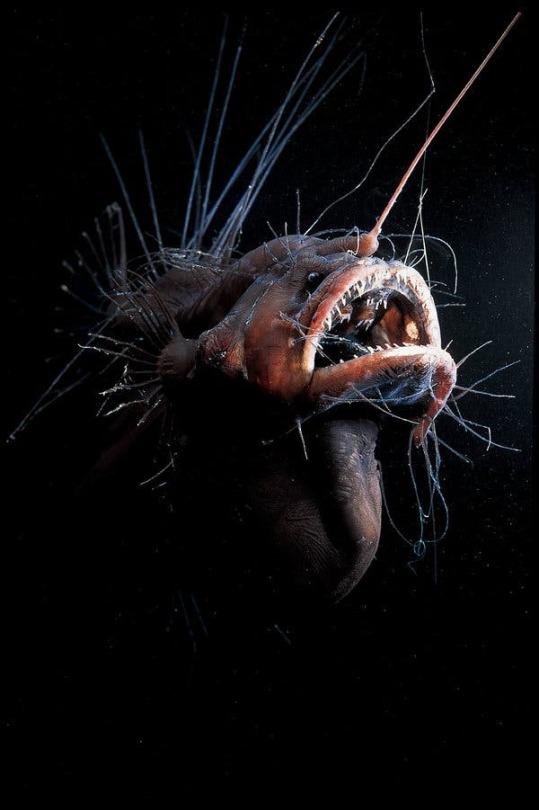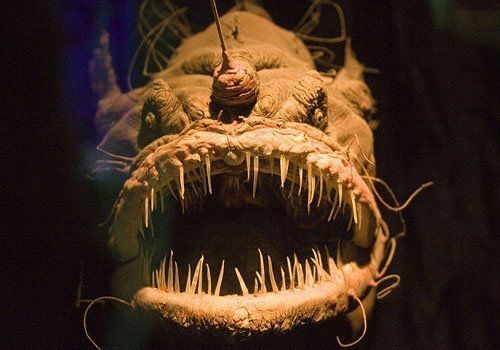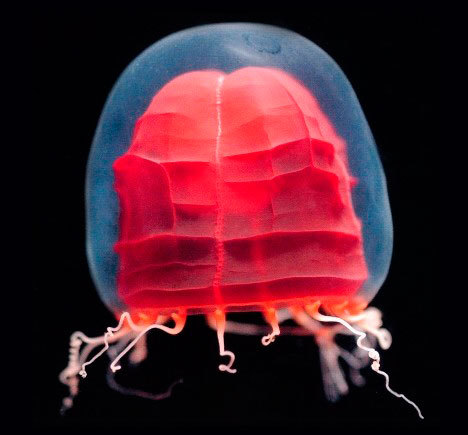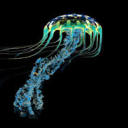Glowing Sucker Octopus


Glowing sucker octopus
Stauroteuthis syrtensis
The Glowing Sucker Octopus can be found at 2500 m in the deep ocean. This unique creature has two fins that look similar to elephant ears. They move elegantly through the water by moving these fins and contracting their mantle. Evidence of this creature has only been spotted in the Atlantic Ocean.
Photo credit: https://octolab.tv/species/glowing-sucker-octopus/
https://ferrebeekeeper.wordpress.com/2011/03/14/glowing-sucker-octopus/
More Posts from Bioluminescentoceangoddess and Others


Lav Polyp
leuckartiara octona
The Lav Polypo is a jelly that comes in a variety of colors and shapes; it dwells about 200m in the deep ocean. The red mass inside its translucent bell is the jelly’s reproductive organs. Furthermore, it uses its dull, yellow tentacles can catch unsuspecting prey.
Photo credit: https://www.pinterest.com/pin/65935582019848580/
https://www.petjellyfish.co.uk/shop/live-jellyfish/leuckartiara-octona

Hula Skirt Siphonophore
Physophora hydrostatica
The Hula Skirt Siphonophore a deep sea siphonophore that is found between 700 m to 1000m. It is made of a colony of hundreds tiny zooids. The top portion of the colony holds the swimming bells, which allow the colony to move. The bottom of the siphonophore holds the orange ‘hula skirt,’ which is full of stinging tentacles.
Photo link : https://twitter.com/montereyaq/status/1162068535331311617?lang=da


Pink Helmet
Aglantha digitale
The Pink Helmet is a mini hydromedusa that comes in a variety of vibrant colors. The tiny jelly is only 4 cm in size and is found towards the surface of the ocean. The purple and blue hues we see in its bell are caused by a phenomenon known as iridescence, when light strikes the jelly’s thin tissue at different angles (similar to what we see in a soap bubbles). It also has orange pigmentation near its mouth; this pigmentation helps attract prey and mask luminescence. Furthermore, females tend to be more colorful than males.
Photo credit: https://biolum.eemb.ucsb.edu/organism/pictures/aglantha.html
https://www.pinterest.com/pin/186899453255850798/


Atolla Jelly
Atolla wyvillei
The Atolla Jelly is a fiery, red jellyfish that has an extraordinary display of bioluminescence. When the jelly is attacked, it uses bioluminescence to produce thousands of vibrant, blue flashes; the blue flashes act as an alarm, which draws in bigger predators and warns prey. The jelly can be found at depths between 600 m to 1500m, and it also has a long hypertrophied tentacle that aids in reproduction.
Photo credit: https://en.wikipedia.org/wiki/Atolla_jellyfish
https://en.wikipedia.org/wiki/Atolla_jellyfish



Black Dragonfish
Idiacanthus atlanticus
The Black Dragonfish are needle-like fish that migrate between 500m and 2000m in the deep ocean. Females are black with 6 stripes and lack a barbel, pelvic fins, and sharp teeth. Males, on the other hand, are dark brown and have a barbel, which is the light producing structure on its chin. Furthermore, it uses bioluminescence to detect prey instead of lure prey.
Photo credit: https://scitechdaily.com/scientists-learn-secrets-from-ultra-black-skin-that-allows-deep-sea-fish-to-lurk-unseen/
https://steemit.com/life/@munnashah/the-most-terrible-and-surprising-7-animals-of-the-sea
https://knowyourmeme.com/photos/995601-thalassophobia


Fanfin Seadevil
Caulophyyne jordani
The Fanfin Seadevil is an ugly, deep fish that is covered in gnarled skin and long sensory filaments. The sensory filaments allow this species of anglerfish to detect movement in the water; this helps the Fanfin find and lure its prey. Furthermore, this deformed monstrosity can be found floating between 700m to 3000m in the ocean.
Photo credit: https://www.nytimes.com/2019/07/29/science/anglerfish-bioluminescence-deep-sea.html
http://www.robotspacebrain.com/alien-creatures-of-the-mariana-trench/


Red Paper Lantern Medusa
Pandea rubra
The Red Paper Lantern resembles a floating, Japanese paper lantern in the deep sea. It has the ability to crumple and wrinkle its bright, red bell, and it is located at depths between 550m to 1200m. It has also been nicknamed the “origami jelly.”
Photo credit: https://commons.wikimedia.org/wiki/Category:Pandea_rubra
http://www.thegorgeousdaily.com/pandea-rubra/


Giant Bell Jelly
Scrippsia pacifica
The Giant Belly Jelly has 256 tentacles attached to a gelatinous bell-shaped base. Like most cnidarians, the Giant Belly Jelly uses specialized stinging cells called nematocysts to catch its prey. When fish and other prey swim into its tentacles, the sensory projection on the cnidocyte (cell that holds the nematocysts) is activated. Then the nematocysts and barb are released, hitting the vulnerable prey and releasing a toxin into the prey’s body. The Giant Bell Jelly is found at 400 m in the ocean. It is related to the jellyfish, but it is categorized as a Hydrozoa (similar to the Portuguese- man-o-war)
https://vimeo.com/42551565
Photo Credit: https://www.pinterest.cl/pin/467107792572034837/
https://courses.lumenlearning.com/ivytech-bio1-1/chapter/phylum-cnidaria/

Crystal Jellyfish
Aequorea victoria
The Crystal Jellyfish is a graceful, transparent jellyfish with long, thin tentacles. It has bioluminescent organs around it bell that produce a bright, green light. It tends to consume small copepods, but it has the ability to swallow other jellyfish half its size. Furthermore, this jelly is used in biological experiments to detect calcium.
Photo credit: https://www.montereybayaquarium.org/animals/animals-a-to-z/crystal-jelly
https://fineartamerica.com/featured/5-aequorea-crystal-jellyfish-with-amphipods-alexander-semenovscience-photo-library.html

Squarenose Helmetfish
Scopelogadus beanii
The Squarenose Helmetfish is found between 800m to 4000m in the ocean. It received this unique name due to its scales reminding scientists of an armored helmet worn by medieval knights. It also has unusual holes around its face, and the white strands covering its face are sensory canals.
Photo credit: https://www.vistaalmar.es/especies-marinas/peces-extranos/449-que-peces-mas-extranos.html
-
 mycellpics liked this · 1 year ago
mycellpics liked this · 1 year ago -
 pacmastermeow reblogged this · 2 years ago
pacmastermeow reblogged this · 2 years ago -
 chimugukuru reblogged this · 2 years ago
chimugukuru reblogged this · 2 years ago -
 pravum-vulpes-umbra-imperatrix liked this · 2 years ago
pravum-vulpes-umbra-imperatrix liked this · 2 years ago -
 theinkandthesea reblogged this · 2 years ago
theinkandthesea reblogged this · 2 years ago -
 theinkandthesea liked this · 2 years ago
theinkandthesea liked this · 2 years ago -
 acepalindrome reblogged this · 2 years ago
acepalindrome reblogged this · 2 years ago -
 scarletta-aesthetics reblogged this · 3 years ago
scarletta-aesthetics reblogged this · 3 years ago -
 tyana-bt liked this · 3 years ago
tyana-bt liked this · 3 years ago -
 the13thgrey-blog liked this · 3 years ago
the13thgrey-blog liked this · 3 years ago -
 theamazingnaturalworld reblogged this · 3 years ago
theamazingnaturalworld reblogged this · 3 years ago -
 crimson-flamez liked this · 3 years ago
crimson-flamez liked this · 3 years ago -
 wachinyeya reblogged this · 3 years ago
wachinyeya reblogged this · 3 years ago -
 gaylienz liked this · 3 years ago
gaylienz liked this · 3 years ago -
 space-mist liked this · 3 years ago
space-mist liked this · 3 years ago -
 oceanblue971 reblogged this · 3 years ago
oceanblue971 reblogged this · 3 years ago -
 turtlepaws84 reblogged this · 3 years ago
turtlepaws84 reblogged this · 3 years ago -
 red-red-spout reblogged this · 3 years ago
red-red-spout reblogged this · 3 years ago -
 nxrtv liked this · 3 years ago
nxrtv liked this · 3 years ago -
 stubbornmarrow liked this · 3 years ago
stubbornmarrow liked this · 3 years ago -
 nerdloves liked this · 3 years ago
nerdloves liked this · 3 years ago -
 brines liked this · 3 years ago
brines liked this · 3 years ago -
 nippongoto liked this · 3 years ago
nippongoto liked this · 3 years ago -
 wise-tortoise reblogged this · 3 years ago
wise-tortoise reblogged this · 3 years ago -
 crnbr liked this · 3 years ago
crnbr liked this · 3 years ago -
 fishofthewoods reblogged this · 3 years ago
fishofthewoods reblogged this · 3 years ago -
 fishofthewoods liked this · 3 years ago
fishofthewoods liked this · 3 years ago -
 acearson liked this · 3 years ago
acearson liked this · 3 years ago -
 zman2526 liked this · 3 years ago
zman2526 liked this · 3 years ago -
 progcinnamon reblogged this · 3 years ago
progcinnamon reblogged this · 3 years ago -
 progcinnamon liked this · 3 years ago
progcinnamon liked this · 3 years ago -
 specsthespectraldragon liked this · 3 years ago
specsthespectraldragon liked this · 3 years ago -
 avicularia liked this · 3 years ago
avicularia liked this · 3 years ago -
 cd20m reblogged this · 3 years ago
cd20m reblogged this · 3 years ago -
 micc0ro liked this · 3 years ago
micc0ro liked this · 3 years ago -
 giantnerdsnake reblogged this · 3 years ago
giantnerdsnake reblogged this · 3 years ago -
 tyrannicalterror liked this · 3 years ago
tyrannicalterror liked this · 3 years ago -
 siberiantrap reblogged this · 3 years ago
siberiantrap reblogged this · 3 years ago -
 freedominart liked this · 3 years ago
freedominart liked this · 3 years ago -
 morphlingunderscore reblogged this · 3 years ago
morphlingunderscore reblogged this · 3 years ago -
 morphlingunderscore liked this · 3 years ago
morphlingunderscore liked this · 3 years ago -
 eldriwolf liked this · 3 years ago
eldriwolf liked this · 3 years ago -
 xisuthrus liked this · 3 years ago
xisuthrus liked this · 3 years ago -
 love-comes-to-town liked this · 3 years ago
love-comes-to-town liked this · 3 years ago

Bioluminescence is a chemical reaction that produces light. Many deep sea animals use bioluminescence. This blog is dedicated to educating the public about the amazing creatures that thrive in the deep sea.
57 posts